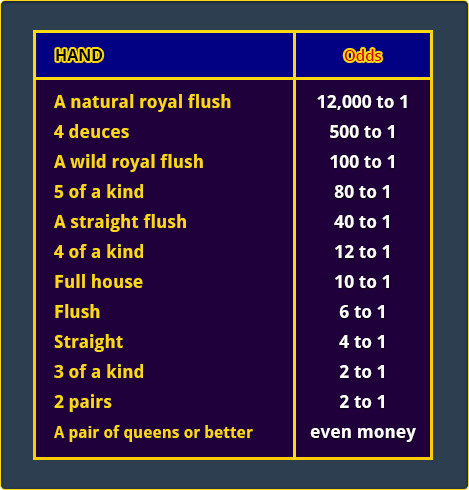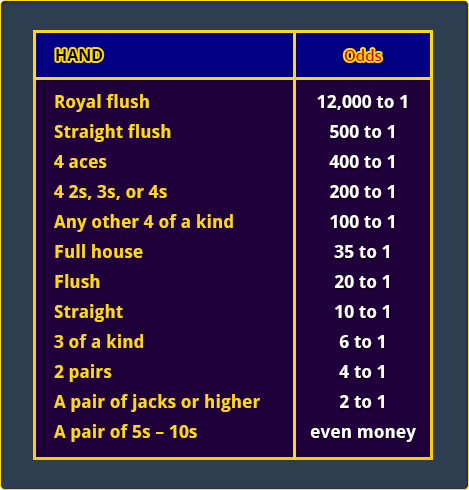Double Pay Poker is a whole family of video poker games that has one big distinction from standard games. You bet on (and get paid off) on both the initial hand you’re dealt AND on the hand that you wind up with after discarding and drawing new cards. This means, of course, that you’re putting twice as much money into action. The payoffs for getting a particular hand on the deal are, of course, significantly higher than the payoff would be if you got it after discarding and drawing to it.
The rest of this page explains how to play Double Pay Poker, what the payback percentage and pay tables for this game looks like, and what kinds of strategy advice you might need to read before playing.
How to Play Double Pay Poker
Double Pay Poker is no different from other video poker games in terms of how you play. You still insert your money into the machine. You still decide how many coins to bet. You still draw a 5 card hand, and you still get to discard and replace up to 5 cards.
The difference is that you get paid on your hand on the deal AND on the hand after you’ve discarded and drawn.
Double Pay Poker isn’t a separate game from other variations. It’s just an additional payout stage and an additional bet, which isn’t an unusual wrinkle in a video poker game.
You can find full details about how to play video poker on our main page, but here’s an overview of how the game works if you’re unfamiliar with it:
Video poker games are gambling machines—they look a lot like slot machines, in fact. But there are 3 major differences between video poker games and slot machine games:
- The payback percentage for video poker is almost always superior to the payback percentage for slot machines.
- You get to make actual decisions in video poker which can affect the odds of walking away a winner.
- The payback percentage for a video poker game is known, while the payback percentage for a slot machine is not.
Most slot machine games have a payout percentage of 95% or less. Most video poker games have a payout percentage of 95% or more.
What’s a payout percentage?
It’s just the mathematically expected average of how much the game should pay out in winnings over time. The number is expressed as a percentage. If you’re playing a game with a 95% payout percentage, you can expect, over a long period of time, to win back 95 cents of every dollar you wager. The casino expects to win the other nickel.
It’s important to understand that this is a long-term expectation, one you’ll see over tens of thousands of hands. In the short run, players walk away winners or sometimes go on bad losing streaks. That’s just the nature of gambling probability.
But if you stick with games with a high payback percentage, you’ll lose less money per hour on average over time. This matters because you should consider playing video poker games like Double Pay Poker an entertainment expense. And with entertainment expenses, you should try to get as much fun for your money as possible.
In most gambling games, including slot machines, you make no decisions of any consequence. You place your bets and hope for the best. But in video poker, you’re going to decide which cards to keep and which cards to throw away. This will have an effect on your overall return—if you discard the wrong cards, you’ll lose more money than you otherwise should or would. In this respect, video poker resembles blackjack.
Finally, we can calculate the payback percentage for a game like Double Pay Poker because we know the probabilities behind the symbol combinations. The entire game is based on a deck of cards. We know there are 52 cards in each deck, in 4 different suits, with 13 different ranks. If you know the payout for a bet and the odds of winning that bet, you know the expected value of that bet.
Double Pay Poker Pay Tables
As we mentioned earlier, Double Pay Poker is just a layer added to the top of another video poker game. So you might easily find the following Double Pay Poker pay tables:
- Double Pay Deuces Wild
- Double Pay Double Bonus
- Double Pay Double Double Bonus
- Double Pay Triple Double Bonus (How’s that for a mouthful?)
The pay tables for the hands after the discard phase are the same as for the original game, but the pay tables for the hands you get on the initial deal take into account the odds of getting that hand dealt without having to draw for it. So those payouts are correspondingly higher.
Here’s an example of a Double Pay Deuces Wild pay table:
The payback percentage for this pay table is 97.84%. To get the overall payback percentage for the game—the cumulative payback percentage—you just average the payback percentage for the payouts before the deal and for after the deal.
Here’s another example, from a Double Pay Double Bonus game. These are the payouts on the deal:
The payback percentage for this table is 96.14%.
How are these payback percentages calculated?
It’s easier than you think, actually. We know the probability of being dealt any of these hands. You simply multiply the probability of being dealt a particular hand by its payout to get its expected return. You add up all the possible expected returns to get the overall expected return for the game.
Let’s use the Double Pay Double Bonus game as an example:
Example
You have about a 60% chance of getting a hand that pays nothing in this game—the expected value of that payout is 60% X 0, which equals 0, of course. You have an almost 20% chance of getting a pair of 5s-10s. 20% X 1 is 20%, which is the result of that hand on your calculations.
The same calculations on the top paying hands are interesting to look at, too. The probability of getting a royal flush is 0.0002%. Multiply that by 12,000, and you get an expected value of 1.8%. The probability of getting a straight flush is about 0.0014 %. Multiply that by 500, and you get an expected value of about 0.7%.
Add all those up, and you get the payback percentage for the game.
Double Pay Poker Strategy
Here’s the thing about Double Pay Poker. It’s basically just an extra bet and an extra payout grafted onto an existing game. But you’re betting on a hand that you’re being dealt initially. There is no strategy to this phase of the game—you’re dealt the hand you’re dealt.
The strategy takes place in the 2
nd phase of the game, and it’s the same as the strategy would be if you weren’t playing Double Pay Poker. So if you want to find the strategy for Double Pay Deuces Wild, visit our Deuces Wild page for details, and just use that strategy. Same for Double Pay Double Bonus.
We have pages with strategy charts for all the major video poker variations that are commonly found in a Double Pay version.
Conclusion
Double Pay Poker is less of a unique video poker game than it is an extra feature grafted onto an existing game. It’s basically just an extra bet and an extra payout on the hand that you’re dealt initially. This bet and its payoffs aren’t affected by any kind of strategy, because you’re getting the cards before having the opportunity to choose which cards to hold and which ones to discard.
The pay tables for this additional bet take into account how much harder it is to get a hand on the initial deal without having the opportunity to draw to it. So the payouts for the hands are bigger, but you’ll see them a lot less often. After all, if you only see a royal flush once in every 40,000 hands when you have a chance to draw to it, how hard must it be to be dealt that hand on your initial deal.
If you enjoy playing Double Pay Poker, you may also enjoy
Double Pay Spin Poker as well.


 75%
75% 80%
80%
